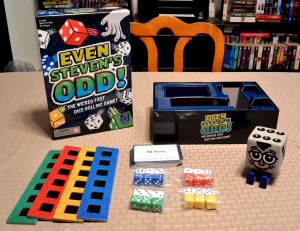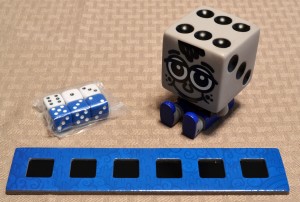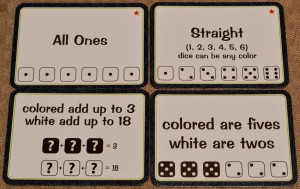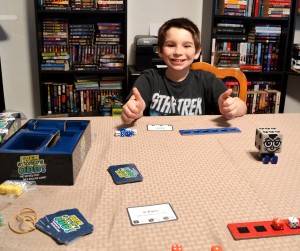Dice and I have a hate/hate relationship. I’m not sure who started the war, but it’s been an uphill battle trying to get them to cooperate when I need them most. Perhaps I’m just one of the unfortunate souls to always be paired with malcontent dice, who take sadistic pleasure in rolling snake eyes every time despite the odds. Despite my luck (or lack thereof), there’s something to be said for easy to play dice games. “Even Steven’s Odd” is one such item, though it does something unique that sets its apart from games like “Yahtzee”. Before we get started with the review, I’d like to thank Nancy Davies, the Vice President of Salmon Borre Group, for providing me with a free press copy.
Components
Dice & Dice Holders – Twenty-four dice are included, which are broken up into four sets of six dice each. Each set has three white dice and three dice of its own player color. Likewise, the four dice holders are player color specific.
Challenge Cards – These forty challenge cards will task players with rolling specific combinations. Cards with the star in the upper right hand corner of the card are designed for younger players and are thus easier to complete.
Steven – This semi-squishable, rubber-like character (who I’ve dubbed Spongebob Dicepants) is who everyone will be aiming to grab in order to win a particular round.
Setup & Gameplay
Each player will choose a set of six dice and a matching dice holder. The deck of challenge cards is shuffled and placed into the middle of the table, along with Steven. If playing with younger kids, use only the cards with the star in the upper right hand corner to give them an easier experience.
The game as a whole is broken up into several rounds. During a particular round, one player will flip over the next challenge card and read it aloud. After that, it’s placed on the table for all to see. At this point, players will race to roll dice (at the same time) and complete the combination listed on the card. They can place dice they want to keep in their dice holder and roll again at will. The first player to complete the combination and grab Steven wins the round, keeping the challenge card so that players can keep track of how many rounds a particular player has won. The person with the most challenge cards after ten rounds, wins the game!
The above doesn’t cover all of the rules found in the manual, but should give you an idea as to how the game is played. For more information, please refer to the manual, linked below for your convenience.
http://www.educationalinsights.com/text/EI/downloads/guides/3415_Guide.pdf
The Review
First, I need to commend the manual for being short and to the point. As a game critic, I often get used to rule books that are twenty pages in length…it’s refreshing to be able to grasp the concept within the first minute of opening the box. The manual in this game, to put things in perspective, is only a page long. In fact, the text is etched on the inside of the box cover. The dice and dice holders were of good quality, as was Steven. I didn’t have any issues reading the cards, nor had problems comprehending the goals listed. There aren’t that many components to keep track of, making setup and cleanup relatively quick. My only complaint was that the card portion of the box insert wasn’t deep enough, causing the top few cards to slide over the top. I recommend binding them with a rubber band.
This game is certainly fast-paced. Players take their turns at the same time, requiring them to be quick on their feet. Of course, parents who play this game with their younger kids can slow their actions down to help balance the game for all involved. I’ll take that a step further and say that turns COULD be introduced, something I actually recommend trying at least once. Those wanting a more chaotic game could keep the rules as-is, but those who don’t like the fast-paced nature of the standard rule set could opt to include player turns. The game turned out to be very flexible in that regard.
The challenge cards themselves were pretty varied, introducing concepts like sequences and runs. The fact that three of the six dice in a set are white adds a bit of variety to the mix, bringing ideas like pattern and color recognition into play. Cards that include both colors up the challenge a bit and make rolling the combination a bit more difficult. Luckily, kid-friendly cards exist (those marked with a star) to keep younger players from getting too frustrated. I mentioned above that the game is mod-friendly…in theory, each player could receive their own challenge cards (adults = challenging, kids = easy) and draw new ones for themselves as they complete them. Again, the game is flexible enough to try out new things for the benefit of catering to your group’s prefered play style.
Overall, we found “Even Steven’s Odd” to be suited for both kids and adults alike. Its family-friendly nature and easy rule set makes the game appealing to players of all ages. There’s an educational value to the game as well, mainly in the form of pattern recognition and number matching. It’s perfect for kids at a grade school level who are just learning the ins and outs of numbers in general. It doesn’t take very long to play, so it makes for an excellent filler in between longer play sessions. It’s also a good choice for school nights, where homework and such take precedence. All in all, “Even Steven’s Odd” is a delight to play!
Final Verdict: 8/10
—
You can learn more about and purchase “Even Steven’s Odd” by visiting the following websites:
http://www.educationalinsights.com/product/even+steven%E2%80%99s+odd–8482-.do?from=Search&cx=0
http://boardgamegeek.com/boardgame/143070/even-stevens-odd
—




